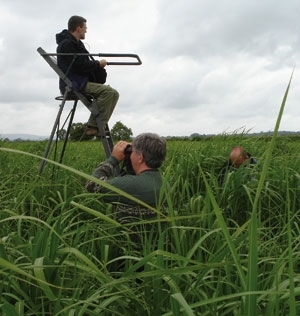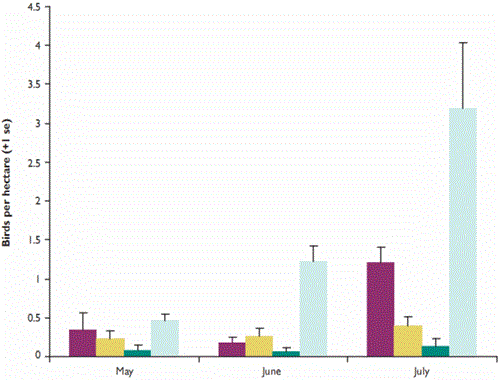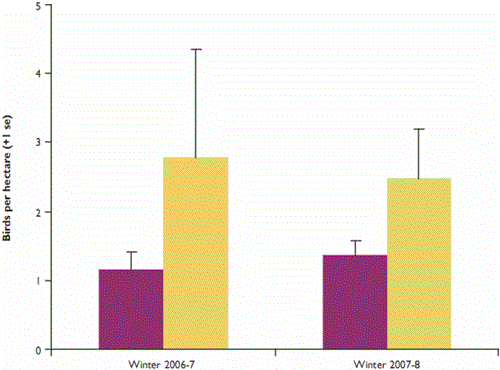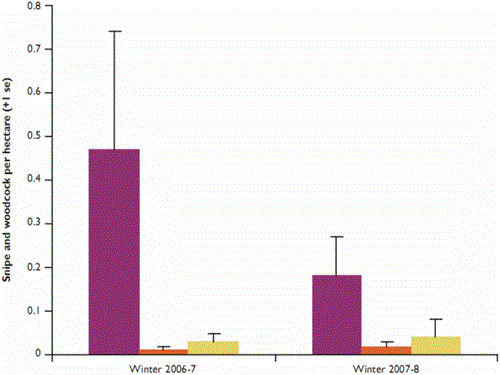 We have shown that commercial willow short-rotation coppice (SRC) can be good for some birds. Certain species can be displaced, for example grey partridges and yellow wagtails, otherwise a variety of farmland, scrub and wood-edge birds can be found in the crop in spring, often at quite high densities – sometimes comparable with scrub or traditional coppice habitats. We think that the birds are attracted by the structure of the crop and may benefit from the high invertebrate abundance found in the willow coppice canopy when rearing broods.
We have shown that commercial willow short-rotation coppice (SRC) can be good for some birds. Certain species can be displaced, for example grey partridges and yellow wagtails, otherwise a variety of farmland, scrub and wood-edge birds can be found in the crop in spring, often at quite high densities – sometimes comparable with scrub or traditional coppice habitats. We think that the birds are attracted by the structure of the crop and may benefit from the high invertebrate abundance found in the willow coppice canopy when rearing broods.
Little work has been done on biodiversity in miscanthus grass (Miscanthus x giganteus), which has quickly become the most commonly-planted biomass crop in the UK. Recent estimates suggest that there may now be about 6,000 hectares in England (figures available from Defra’s Energy Crop Scheme) and, although there are varying projections for future acreage, it could become a major crop.
Figure 1: Mean number of birds per hectare (excluding corvids) recorded during May, June and July in 16 miscanthus fields, compared with adjacent control plots

In 2006, we were asked by Rothamsted Research to join a research programme that aims to explore the social, economic and environmental effect of widespread biomass cropping in the UK, including biodiversity. The project overall will report during 2009; however, we did the bird surveys and our findings are described here.
We counted birds monthly at 15 recently-planted commercial miscanthus sites in winter and summer from 2006 to 2008. The sites were mostly in the south west, had been established well and were well managed. We compared these with adjacent fields of grass or cereals and, in summer only, with a group of SRC fields that had been cut the previous winter. In May and June following harvest, the height of the miscanthus was low enough to allow birds to be surveyed by systematically walking along transects through the crop (as in the control plots). However, in the winter and in latesummer, its height and density (more than two metres) demanded a novel technique involving two surveyors, one watching from a high vantage point (usually a deer seat) while the other walked through the crop flushing birds.
Figure 2: Mean number of birds in miscanthus plots compared with grassland and arable fields

There tended to be fewer birds in the miscanthus plots compared with the primarily grassland fields that the miscanthus plots in the south west region had replaced. However, the difference was not significant because of high variance in control plots.
We found that encounters with territorial male birds in miscanthus in May and June were low compared with the cut SRC, but similar to the (much larger) cereal control fields (see Figure 1). In July, encounters with post-breeding individuals, primarily blackbirds and reed buntings, were greater in miscanthus compared with the controls, but still lower than in the recently cut SRC. In winter, we encountered birds in miscanthus plots at similar or slightly lower densities to those in the controls (see Figure 2). Thrushes (mainly blackbirds) were most common, whereas woodcock and snipe were attracted to open patches in this otherwise dense crop (see Figure 3). In both summer and winter there tended to be slightly more species in miscanthus fields compared with the controls.
This last finding suggests that bird numbers in miscanthus (and SRC) could be improved by changing plantation design (eg. including a ride) and managing it differently. However, when planted under Defra’s energy crop grant scheme, these biomass crops are currently largely excluded from Environmental Stewardship (ES). We think there is scope for well-researched plantation design and management protocols to be included in ES that could improve the crop’s value to wildlife.
Figure 3: Mean number of snipe and woodcock using open and dense miscanthus and adjacent controls

Acknowledgements
This work was funded by Research Councils via the Rural Economy and Land Use (RELU) programme and by Defra. The RELU-Biomass programme is led by Rothamsted Research. We are very grateful to the growers of miscanthus in the south west for allowing us to undertake this work on their land.